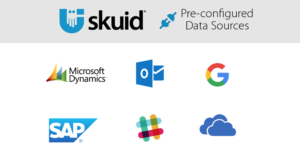
As Griffin Brown pointed out in the Skuid Community, Skuid releases are so jam packed with features and functionality, it’s easy for a few of them not to get the attention they deserve.
This is the case especially for Skuid Brooklyn, which added many new features in addition to the exciting announcement of the Skuid Platform.
Not to worry though Griffin, and other Skuid feature fans, in this blog I’ll make sure the latest and greatest Skuid features have their day in the sun. Read on to discover some of the amazing new tools now available in Skuid.
Build for desktop and mobile in a single composer.
You want to design apps that go where your people go. That means your apps need to be mobile, literally.

Until Skuid Brooklyn, in order to design mobile apps, you had to use the Skuid Mobile Composer, which had its own unique set of features specifically for mobile devices. We’ve been hearing for a while now that our customers want access to the mobile tools in the desktop composer as well.
The wait is over! We’ve brought mobile-specific features of the Mobile Composer, like sliding panels and mobile gesture, into Skuid’s desktop-based App Composer. This means you can build all of your apps in one interface, no matter where your users may take them.
If you’re on a touchscreen, gesture controls are supported, no matter what device you’re working with. So, wherever you are, whatever device you want to build for, you have access to everything you need.
Create mobile-friendly experiences quickly.
Building for mobile comes with its own set of unique considerations. For instance, if you’re all thumbs like me, it’s very hard to use a Skuid Table when accessing an app from your phone.
Now that mobile features are included in the desktop composer, you can use the Deck component to create ‘cards’ for account, contact, or really any kind of record and have those cards be responsive in deck form on your desktop. This is a handy way to make those records pop on the screen visually and be easy to interact with on a touch screen.
Speaking of touch screens, you can set different Interactions, or Gestures, for cards in the Deck. For example, if you want the record detail to open when you press down on the card, you can make that happen. This ability is now also available in the Queue and Image components.
Get more functionality from Button and Filter sets.
The Button and Filter Sets are more like feature enhancements than brand new features, but power users of Skuid will greatly appreciate the updates to buttons and filters. The Button Set component means that you no longer have to place a Page Title component on a page to add a button. The Button Set now has its own specific layout features, such as being able to control the position of buttons on the page.
Give end users Table configuration options.
Since its arrival in the Skuid product, the Table component has made it easy to configure columns and rows of data in spreadsheet form, but only people building the apps could wield that power. Now, admins have the ability to put that power into the hands of the end user.
With a simple click, end users can rearrange Table columns to their specifications. Using the Skuid Personalization Framework, their Table views are saved, so every time a user logs in, their view of the Table is preserved. Having the ability to hide, show and optimize the view can make all the difference in your user’s day-to-day workflow and save them lots of time and confusion.
Filter Sets now allow filters to be free of the Table component. Any components attached to the Filter Set’s model will now be affected by the filter. This means that if you want to filter a table and a chart at the same time, it’s now much easier to make this happen. These enhancements make building in Skuid that much more efficient and easy.
Connect to even more data sources.

It used to take a lot of maneuvering to set up Data Source connections and Models. With Skuid Brooklyn that process is now streamlined.
Rather than hunting down tons of different parameters and endpoints, Skuid’s Data Source creation wizards make it easy to create your connections. And creating Skuid models for your Google or Outlook calendar is as easy as setting up any other model. Just select the Data Source, enter your data object, and pick the fields you want to use.
It’s that simple to hook into tools like your Google or Outlook calendars, Slack messages,or OneDrive files. For a full list of the pre-configured data sources now in Skuid, see the release notes.
Create branching logic.
Skuid strives to uncomplicate placing complicated logic into your applications. Suppose, for instance, that I want to create actions that occur if something else has occurred, like this:
- When an Opportunity has been set to Consideration, show a “Set New Task” button.
- If the contract is set to Closed Won, I want a “Party time!” button to show up.
Pre-Brooklyn, you had to paste snippets of JavaScript into the App Composer to make if/else statements like this in your app. No longer! Now Branch is included as an action type in the Action Framework.
This means that you no longer need any knowledge of JavaScript to write logic, making your applications that much more comprehensive and your Skuid skills that much more impressive. Way to go, you!
Show and hide content with Sliding Panels.
Sliding Panels are primarily used to create hidden content that will slide into view during certain interactions. You can use them for optional information, hidden menus, or sidebars on mobile.
Similar to Skuid popups, now you can insert Sliding Panels into your page using an Action Framework action type. It’s kind of like hiding cool stuff in your sock drawer, except it’s not shiny rocks or candy, it’s a portal to a whole new world of awesome data for your users. Sliding Panels even come with options for different kinds of slide styles, like overlay, reveal, or push.
Other common use cases for sliding panels are hamburger menus and hidden tabs. So there you have it, Griffin. I hope that satisfies your craving for more new feature fanfare. If you’re thinking, “Holy functionality, Batman!
That’s a lot of cool new stuff,” just wait until you see our release notes for Brooklyn. That’s right, there is even more that I didn’t get to. Watch the Brooklyn Release Webinar to see these new features in action.




